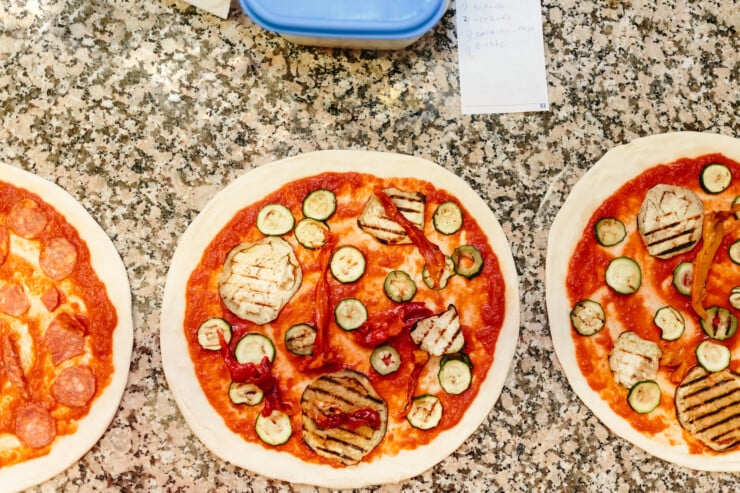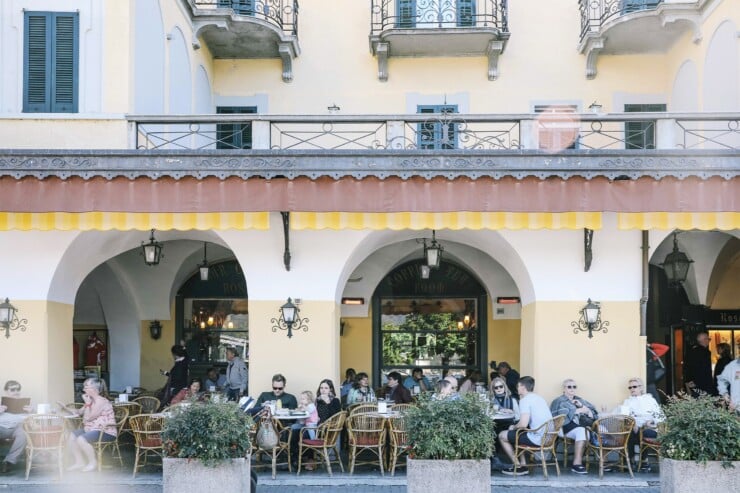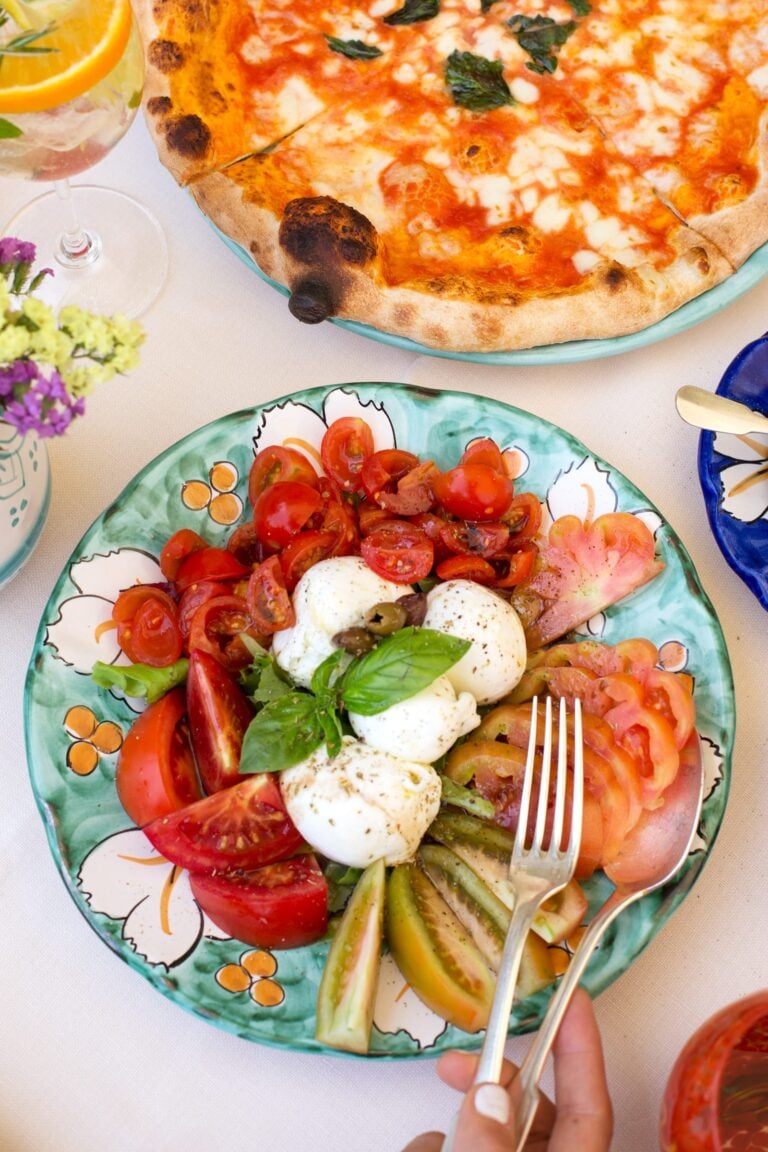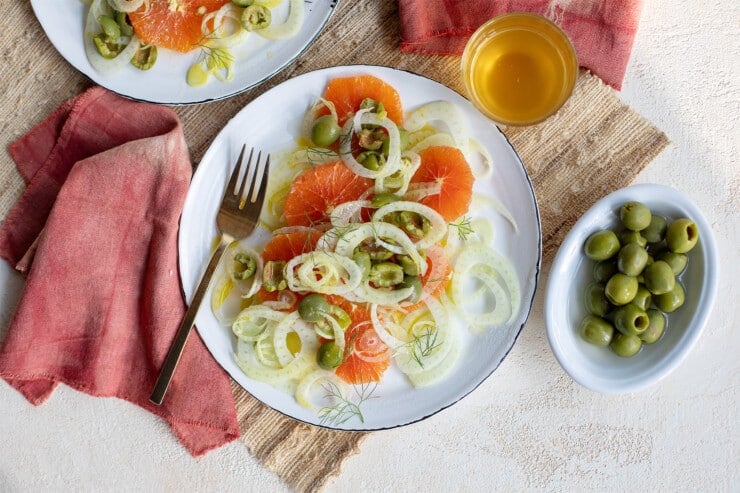I am a carb lover—I always have been and always will be. So, imagine my surprise when my second child was born and we discovered he was allergic to wheat. Suddenly, and unexpectedly, my whole family had to become gluten free in Italy.

Key Takeaways
- It is possible to travel gluten free in Italy so long as you know a few things about labeling and a few key phrases.
- There are a lot of resources including apps and gluten-free restaurants that those avoiding wheat or gluten can use to travel easier.
- Some Italian dishes are naturally gluten free so you can order those when in doubt.
I couldn’t believe it—my half-Italian child could not taste all my favorite foods—bread, pasta, and pizza! He would never taste my Italian husband’s homemade breads, pizza in Naples with my Southern Italian family, or fresh pasta recipes passed down from my mother-in-law; it was all off the table.
Luckily, I was half a step ahead because I had planned gluten-free trips for our Italian travel clients. However, without warning, I was thrown headfirst into navigating Italy and Italian food daily without wheat.
Slowly, over the next year, I started gathering information and resources. I began to realize that a lot of Italy was pretty accommodating to celiacs and wheat allergies, like my son. I found delicious pizza, pasta, and more, and with a bit of planning, I learned you can live a pretty normal life while being gluten free in Italy. Now I’ve taken all this knowledge and compiled it for you.
So, whether you have celiac, are allergic, or are on a gluten-free diet, read on to travel Italy safely and deliciously without wheat. This article will cover the challenges of being gluten-free in Italy, understanding gluten-free labeling in Italy, where to find gluten-free products, essential phrases, and my favorite gluten-free dishes and places to eat in Italy.

Pros and Cons of Traveling to Italy While Being Gluten Free
Before you hop on a plane, consider the pros and cons of traveling to a foreign country with dietary restrictions. Here are some positives and challenges to prepare you for your trip.
- Pro: Italy, in general, has a decent understanding of gluten-free requirements
- Pros: There are lots of gluten-free options in bigger towns
- Pro: Gluten-free food is generally affordable
- Con: If you don’t speak Italian, the language barrier can make it challenging to communicate your dietary needs
- Con: Small towns may not offer gluten-free options that are safe for those with allergies or celiac disease in restaurants
- Con: Navigating a foreign country with a dietary restriction can sometimes be confusing and overwhelming.

Understanding Gluten-Free Labeling in Italy
If you’ve reviewed the pros and cons and feel you can handle it, you’ll want to learn about gluten-free labeling in Italy. It might surprise you, but today, about 1% of Italians have celiac disease and even more avoid wheat for other reasons. To protect this growing population, gluten-free products in Italy are clearly labeled to ensure consumer safety.
Italy even developed a symbol called the “Spiga Barrata,” or a crossed-out wheat stalk. This symbol indicates that the product contains less than 20 parts per million (ppm) of gluten, which is aligned with international standards for gluten-free foods. Additionally, products labeled “senza glutine” (gluten-free) are regulated and must meet the same safety threshold listed above.
Clear labeling is a positive, but while discussing labels, one big thing to look out for in Italy (and Europe in general) is deglutinated wheat flour. On the label, you will see “amido di frumento” or “farina deglutinata,” a starch made from wheat that has had the gluten removed. This is primarily a problem for those allergic to wheat, as it is a wheat ingredient.
If you have this sensitivity or allergy, look for deglutinated wheat in products like breads, pizza, and desserts. It’s also becoming increasingly popular in restaurants since it acts and cooks like regular wheat flour. One of the most popular deglutinated flours is from the famous Naples-based flour brand, Caputi. If a restaurant uses that brand, especially the “Fioreglut” version, you can be sure the product is made with deglutinated wheat starch.

Where to Buy Gluten-Free Food Products in Italy
Gluten-free food products are available throughout Italy. Major European grocery stores like Conad, Carrefour, Pam, and Coop even have a gluten-free section and offer a variety of gluten-free products from breakfast croissants to breads, cookies, and pasta, under their label. You can also find the most famous gluten-free brands, like Schar, widely available throughout supermarkets in Italy.
If you’re in small villages, their market may not have many options, so consider a stop in a pharmacy. Almost all pharmacies carry gluten-free food items. If you’re going to a remote village, consider packing some gluten-free pasta and other essentials with you, as you may not find as many options in truly off-the-beaten-path locations.
Lastly, Italy has 100% gluten-free specialty stores. These establishments sell exclusively gluten-free products and are popular among locals. My favorites are Riccardo Gasperini Senza Glutine in Florence, MEA Libera Tutti in Venice, and Celiachiamo Lab in Rome.

Essential Italian Phrases for Traveling Gluten-Free In Italy
Knowing key Italian phrases can significantly enhance your dining experience and meet your dietary needs. Here’s a list of essential terms to help communicate your dietary requirements and restrictions:
- Avena (ah-vey-nah) – Oats
- Contiene glutine (cone-tyen-ay, gloo-tee-nay) – Contains gluten
- Frumento/Grano (froo-mento / grah-no) – Wheat
- Ha qualcosa senza glutine? (hah, kwal-coz-uh, sen-zah, gloo-tee-nay?) – Do you have something without gluten?
- La contaminazione (lah, cone-tah-mina-tzee-oh-nay) – Cross contamination
- Orzo (ohrt-zo) – Barley
- Può contenere glutine (Poo-oh, cone-ten-air-ay, gloo-tee-nay) – May contain gluten
- Segale (seh-gah-lay) – Rye
- Senza glutine (sen-zah, gloo-tee-nay) – Gluten-free
- Sono celiaco (or celiaca) (soh-no, chel-EE-ah-ko/chel-EE-ah-ka)– I have celiac disease (Insider tip: Use the “a” ending if you’re a female and the “o” ending if you’re a male)
Pro Tip: Prepare for your next trip to Italy by reviewing these 105 basic Italian expressions for travel!

Resources for Celiacs in Italy
Dedicated Gluten-Free Restaurants
There are enough gluten-free restaurants in Italy that, depending on where you go, you could plan your entire trip eating at only certified gluten-free establishments. These establishments are celiac-safe restaurants and eliminate the risk of cross-contamination by using separate kitchens and equipment. This could be a good solution for your Italian vacation if you’re severely allergic or have a gluten intolerance.
Italian Celiac Association (AIC)
The Associazione Italiana Celiachia, or Italian Celiac Association, also known as just “AIC,” is Italy’s national celiac organization and a crucial resource for gluten-free travelers. It provides certification and training to restaurants and establishments that meet stringent gluten-free standards, ensuring a safe gluten-free dining experience.
For a small fee ($3.99 for two weeks of use), the AIC also offers an app that allows users to locate certified gluten-free restaurants and markets across Italy that have been vetted according to its strict standards.

My Favorite Gluten-Free Dining In Italy
A quick Google search will reveal how many restaurants offer gluten-free options in Italy. Below are some of my favorites. Not all of them are 100% gluten-free, so there is a slight risk of cross-contamination, but they are certified by the AIC.
Florence
- Osteria dello Sgrano, Via dei Benci 30R, Florence, Italy
This quaint osteria is known for its gluten-free Tuscan cuisine. You can find everything from paninos made with house-made schiacciata bread to pasta, gluten-free beer, and more. - Ristorante Quinoa, Vicolo di Santa Maria Maggiore 1, Florence, Italy
Ristorante Quinoa is a 100% gluten-free restaurant offering a diverse menu of Italian and international dishes. Insider tip: It might seem unexpected, but my favorite dish here is the pad-thai!
Milan
- Bistro, Corso Magenta 9, Milano MI, Italy
- This is a panino shop that also does homemade pasta. Everything is delicious and 100% gluten-free.
- GluFree Bakery, Via Curtatone 6, Milano MI, Italy
A 100% gluten-free bakery offering a range of sweet and savory items, plus lunch. It’s open all day until 6:00 PM, so it’s a good option if you’re in a rush and need a bite.
Rome
- Mama Eat, Via di S. Cosimato 7/9,Roma RM, Italy
This is a casual modern eatery that is 100% gluten-free. They offer everything from pizza to pasta to burgers. - Pantha Rei, Via della Minerva, 19, 00186 Roma RM, Italy
While not entirely gluten-free, they offer AIC-certified gluten-free dishes, a dedicated preparation space, and a robust menu of items that can be made gluten-free. It’s an excellent option for traveling with gluten and non-gluten eaters.

Naturally Gluten-Free Italian Foods
While Italy is notorious for its pasta and bread, the country’s delicacies also include a wide range of delicious dishes that are naturally gluten-free. These traditional Italian foods are typically made without wheat, but always check with the staff to be sure there isn’t cross-contamination or some “secret” ingredient in their version, which may deviate from the usual gluten.
Amaretti
The artisanal version of this classic meringue-style almond cookie is made with almond flour, egg whites, and sugar and is naturally gluten-free!
Brutti Ma Buoni
Translating to “ugly but good,” these cookies are meringue. You’ll find a few types throughout Italy, but the classic ones from Piedmont and Lazio are made with hazelnuts, while those from Tuscany are made of almonds.
Caponata
A Sicilian eggplant dish cooked with tomatoes, olives, and capers, it’s naturally gluten-free and flavorful.

Caprese Salad (Insalata Caprese)
The classic Caprese Salad usually completely gluten-free, a simple and refreshing salad of tomatoes, fresh mozzarella, basil, olive oil, and salt.
Carpaccio
Thinly sliced raw meat or fish (often beef) is drizzled with olive oil and lemon juice.
Castagnaccio
A dense Tuscan cake made from chestnut flour, raisins, pine nuts, and rosemary, it’s a classic Tuscan food and a naturally gluten-free treat popular in fall and winter.
Farinata
One of the most classic Liguria foods and a favorite among our resident gluten-free eaters, farinata, is made with chickpea flour and Ligurian olive oil. It is a must-try street food in Genoa.
Frittata
This is an Italian-style omelet made with eggs, vegetables, and cheeses. A frittata is baked or fried and usually doesn’t contain flour. Insider tip: In Italy, eggs are not a breakfast food. They’re often served for lunch or dinner instead.

Gelato
Authentic Italian gelato is often gluten-free, particularly fruit-based (sorbetto) flavors. Always check for additives or cookie mix-ins, and inquire about cross-contact from the paddles they use to scoop the ice cream. When in doubt, most large cities offer 100% gluten-free gelato establishments.
Grilled Seafood (Pesce alla Griglia)
Fresh fish and shellfish grilled with olive oil and herbs are especially delicious (and fresh) in coastal regions like Liguria and Campania.
Octopus Salad (Insalata di Polpo)
Boiled and sliced octopus is mixed with olive oil, lemon, garlic, parsley, and sometimes potatoes and olives to create a light, summery, and gluten-free dish.
Panna Cotta
A classic dessert from Piedmont, panna cotta is traditionally gluten-free, a silky, creamy dessert made with cream, sugar, and gelatin and topped with chocolate or fruit.
Polenta
Traditional polenta is made 100% from boiled cornmeal. Polenta is a versatile staple, often found in Northern Italy, that can be sliced, grilled, fried, or served creamy, and works as a base for meat or vegetable dishes. I love polenta with ragu on top; it is delicious and 100% gluten-free.

Prosciutto e Melone
Thinly sliced cured ham is served on top of huge slices of cantaloupe. This classic summer appetizer does not require bread. You can sometimes also find variations such as Melone e Mozzarella, too!
Risotto
If you’re craving the cozy feeling of pasta but gluten-free pasta isn’t on the menu, consider risotto! This rice-based dish is often cooked slowly with broth, onions, cheese, mushrooms, or seafood. It’s delicious and starchy and scratches that pasta itch.
Roasted or Grilled Meats
Many Italian meat dishes, like porchetta (stuffed roasted pork), are seasoned with herbs and garlic, so no breading or flour is needed. The same applies to grilled meats like sausages and steak like tagliata.
Zuppa di Legumi
A hearty soup made from legumes like lentils, beans, and chickpeas is perfect for a warming gluten-free meal. Before ordering, just make sure they don’t add pasta to their version!

Frequently Asked Questions About Gluten Free In Italy
Many hotels in Italy are increasingly accommodating to gluten-free diets. It's advisable to inform the hotel of your dietary needs to ensure they can provide suitable options.
While many Italians speak English, learning a few basic Italian phrases can enhance your dining experience and help communicate your dietary needs more effectively. See the section above on Italian phrases for some suggestions.
If you're highly sensitive to gluten or allergic to wheat, consider dining in only 100% certified gluten-free establishments. Look for deglutinated wheat ingredients, especially in pizza, bread, and baked goods.
If you can access kitchen facilities, Italy's supermarkets provide an excellent selection of gluten-free products. This allows you to prepare your meals with confidence.Lorem ipsum dolor sit amet, consectetur adipiscing elit. Ut elit tellus, luctus nec ullamcorper mattis, pulvinar dapibus leo.
Yes! Italy offers a variety of gluten-free pizza and pasta options. Some pizzerias, especially in Naples, have perfected gluten-free crusts, ensuring a delicious experience for those with celiac disease. Just be wary of "deglutinated" wheat, which we discussed in the label section. If you're allergic to wheat, these products, while gluten-free, do contain wheat.
Absolutely. Major supermarket chains like Coop, Conad, Esselunga, and Carrefour carry their label and international gluten-free brands.
Using a gluten-free restaurant card in Italian can be incredibly helpful. These cards clearly explain your dietary restrictions to restaurant staff. The Gluten Free Card Project offers printable and wallet-sized cards for free.
Look for the AIC certification sticker on restaurant windows. Some restaurants may also serve gluten-free dishes on distinct-colored plates to indicate their gluten-free status.
The AIC offers a mobile app called AIC Mobile, which provides a map of certified venues across Italy.
Yes! Italy is often considered one of the most celiac-friendly countries in the world. The Italian Coeliac Association (AIC) has established a nationwide program called Alimentazione Fuori Casa, certifying over 4,000 restaurants, pizzerias, hotels, and cafés as gluten-free safe. These establishments undergo regular training and inspections to ensure compliance with strict gluten-free protocols.
Get A Personalized Travel Itinerary

Gluten-Free Italian Recipes
Not leaving for Italy yet? Cook these gluten-free Italian recipes!
- Basic Creamy Polenta with Melted Peppers and Mushrooms Recipe
- Creamy Pesto Sauce Recipe
- Fennel and Orange Salad
- Fried Italian Zucchini With Mint Recipe
- Garga Arugula Avocado Hearts Of Palm Salad Recipe
- Parmigiano-Reggiano and Walnut Celery Salad Recipe
- Italian Butter Chicken
- Lemon-Garlic Basil Artichoke Chicken Recipe
- Hazelnut Chocolate Baci Gelato
- Classic Italian Panna Cotta Recipe

Italy Travel Guide
Looking to travel to the Bel Paese soon? Check out our Italy Travel Guide for more cultural tips, itinerary ideas, and advice on what to eat and where to stay.